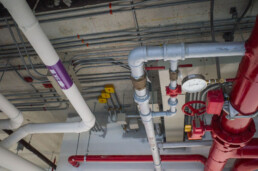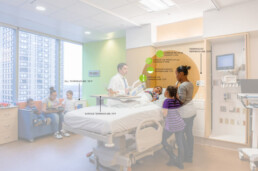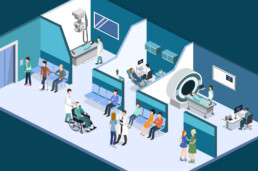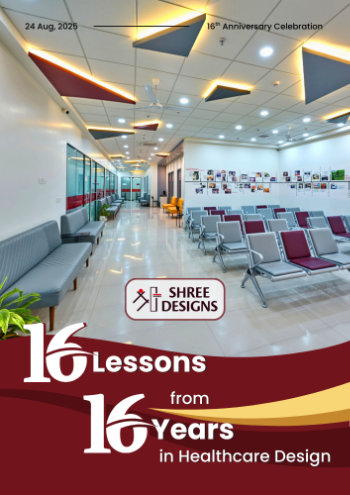Healthcare design is a dynamic speciality that changes rapidly with the times. It’s not surprising because the medical field is constantly evolving as well. Healthcare is not just limited to curing physical conditions. Providers are now looking at holistic methods to improve patient well-being – physically, mentally, and spiritually.
As we see the trends changing, we can also understand the reason behind the shift. The focus on patient-centric design leads to organizations that earn not just patient satisfaction – but patient DELIGHT!
“Most hospitals have been focused on the back-of-house operations, where everything was about volume and efficiency. Now the value is shifting to the front of the house and the customer service aspect,”
Michael Lied, Director of Healthcare, Principal, GBBN Architects
Here are a few patient-friendly design trends that work for many healthcare facilities – from hospitals to polyclinics and private consulting areas.
1. Waiting Rooms
The era of large, sterile waiting rooms with rows of uncomfortable seats is fading to give way to more inclusive spaces. These waiting rooms are designed keeping both patients and their caregivers in mind.
We see a move towards large, airy spaces with community-friendly seating around small tables. The key is flexible layouts that can be reconfigured later for after-hours group appointments or classes and various seating arrangements depending on the number of people.
In the spirit of positive distraction, we also see waiting rooms with large windows for natural light and ventilation that can immediately inject a soothing and calm vibe into any space. Television screens compete for space with aquariums and art installations that provide interest in otherwise sterile surroundings. Small play centres or interactive displays are also becoming more common to keep children or paediatric patients engaged in waiting rooms.
2. Wayfinding
Patients, relatives, and caregivers may have to navigate multiple departments, offices, or wards within the healthcare facility. Clear and unambiguous directional tools will help maintain patients’ privacy, manage visitors, avoid disturbances and help orient visitors to the facility.
Examples of effective wayfinding techniques include:
- Color-coded strips or lines marked on the floor or walls indicating directions.
- Glowing signs and indicators for ensuring patients’ privacy and reducing accidental disturbances.
- Manned guiding stations are recommended to orient people to their destinations in specific scenarios, especially those under community care.
- Using artwork and design elements to make areas stand out. These act as landmarks for patients navigating large or confusing healthcare campuses.
3. Privacy
Patients staying in a care facility for extended periods often acutely feel a lack of privacy. Even simple design solutions can create opportunities for personal space for patients who may feel like they have none. Studies have shown that reducing crowding by providing private rooms and multiple communal areas may lessen patient and employee stress and aggression.
Careful consideration of colours, furniture, lighting, and other elements, makes patients feel at home, with enhanced privacy and dignity.
Patient privacy can be maintained even in busy healthcare facilities. A few examples of such measures are:
- Using space dividers or curtains to enclose cubicles instead of building open emergency bays in casualty areas.
- Operable integrated blinds in windows
- Zoning patient rooms for activities: provider, patient, and family members
- Separation of the path of travel for patient movement versus the public
- Zoning of waiting areas for different activities, including private work, TV watching, and kids’ activities
- Acoustic separation of spaces
4. Sterility and Hygiene
Post-pandemic healthcare design must facilitate a new, emerging requirement of patients and clients. They need to be assured of extra comfort in health and hygiene.
Hence, every aspect of architecture and design will be required to incorporate features that protect patients and staff from potential infections. Below are a few examples that combine effective use while ensuring that common areas remain clean and sterile.
- Air conditioning technology is configured to incorporate fresh air circulation and has inbuilt mechanisms like UV filtration.
- Entrances are designed with contactless technology for the entry and movement of people.
- The dichotomy of space utilization versus social distancing can be handled through management systems which can reduce the long waiting lines, thus reducing the need for vast waiting spaces and preventing crowding of people.
- Healthcare-grade finishes that strengthen sterility are used for all significant areas susceptible to the spread of infections. These products include floorings, laminates, curtains, bedding, and anti-Viral coatings for various surfaces.
Our blog, which delves into other aspects of pandemic preparedness in healthcare facilities, is linked here.
5. Safety and Accessibility
The common spaces in healthcare facilities, such as entrances, corridors, staircases, etc., typically see a lot of movement of humans and equipment. The mobility for patients, independent and assisted, can be improved by providing the following.
- Ramps with proper gradients and non-slip surfaces at the entrances to facilities and at all level-changing locations.
- Handrails and grab bars at strategic locations, mainly staircases, ramps, toilets, and elevators.
Our blog linked here looks at various other factors that contribute to patient safety in a hospital setup.
Conclusion
The quality of a healthcare institution is determined by its ability to provide exceptional community healthcare facilities with the flexibility of maintaining excellent patient-centred care.
The ultimate goal is to restore health for individual patients or as a part of community care. This makes patient-centred care and community healthcare the two sides of the same coin.
“Our motto of creating healing spaces is a challenge that encourages us to push our creative and logical limits. Moreover, it gives us immense satisfaction to contribute to an industry built around improving people’s well-being and is of national importance. This is what keeps us going!”
Kshititi Nagarkar, Principal Architect, Shree Designs.
At Shree Designs, our inspiration doesn’t come from our focus on just creating efficient hospitals – it comes from our mantra of Creating Healing Spaces! We are proud of our work on various projects that have kept patient well-being at the forefront of design.
Take a look at the wide range of greenfield and brownfield healthcare design projects that keep the patient-centric design in the spotlight!
Related Posts
Optimising Operations and Safety
How MEP Systems Keep Hospitals Running Smoothly
In hospitals, design reliability goes far beyond aesthetics. Every breath of clean air, every…
Optimising Operations and Safety
What Is Thermal Bridging?
Thermal bridging might sound like a technical detail - but in healthcare buildings, it can directly…
Optimising Operations and Safety
Community Diagnostic Centres
With CDCs (Community Diagnostic Centres) becoming a key part of India’s healthcare expansion, we’re…
Optimising Operations and Safety
Tech-Powered Healthcare Design
Limited space is one of the biggest challenges for hospitals, clinics, and wellness centres - but…
Optimising Operations and Safety
Rethinking Hospital Staff Areas
Hospital staff is the backbone of healthcare, and their well-being is essential for exceptional…
Optimising Operations and Safety
Fireproofing in Healthcare Design
Designing healthcare facilities isn't just about aesthetics—it's about ensuring the safety and…
Optimising Operations and Safety
The Role of Acoustics in Healthcare Facility Design
Sound matters in healthcare design. From optimizing acoustics to ensuring patient tranquillity, the…
Optimising Operations and Safety
Overcoming Unexpected Challenges in Hospital Design
The intricate world of hospital design is filled with unique challenges. From ensuring impeccable…
Optimising Operations and Safety
Navigational Design in Hospitals
Navigating a healthcare centre can be an overwhelming experience for patients and visitors alike.…
Optimising Operations and Safety
5 Design Tips to Keep your Healthcare Facility Safe and Sterile
Stringent infection prevention and control measures in hospitals are rapidly becoming the norm in a…
Optimising Operations and Safety
Isolation Rooms – The Need of the Hour
Novel Coronavirus outbreak has left healthcare practitioners as well as the common man, concerned…
Optimising Operations and Safety
COVID-19 : Business Continuity Plan
Due to the outbreak of the unprecedented pandemic we at ShreeDesigns are conscious of the…
Optimising Operations and Safety
Social Distancing
Social distancing, a concept that has been around for ages, is one of the most vital measures…













